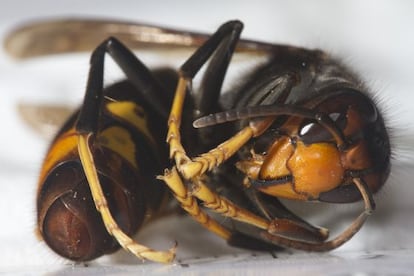Racing against the clock to find Catalonia's hornet invaders
Hundreds of specimens of "the Asian predatory wasp" were found last month in Vall d'en Bas

It's a threat to bees and fruit orchards. It can grow to four times the size of the European bee, which is its main source of food. Its sting is particularly painful. And it has established itself in Catalonia.
Hundreds of specimens of Vespa velutina, a species of hornet known popularly as "the Asian predatory wasp" or "the Asian hornet," were found last month in the Vall d'en Bas, a valley in the Catalan municipality of La Garrotxa. The find has sent all kinds of alarms ringing among rural officials and local beekeepers, who know time is running out: if the nest is not found and destroyed by November, the females growing within will fly out and start their own colonies elsewhere in the region.
"Before the fall is out, the more than 200 wasp mothers now germinating inside the nest will seek new locations to create new hideouts and hibernate," explains Josep Vilar, chief of the rural agents of La Garrotxa. Each female can produce over 12,000 offspring.
Volunteers from the rural union Unió de Pagesos have joined the search for the nest, although some people believe there might be more than one. "Considering the vast amount of specimens we have found, we assume there is not just one; we're not really sure what we're looking for," says Josep Maria Clarià, head of the union's beekeepers sector.
Despite the ongoing efforts, which include searches on foot and traps, the nest or nests remain elusive. So the hornet hunters have taken out the big guns: a helicopter equipped with a heat-sensitive camera that will hopefully detect the nest.
"We go out in the mornings, when the temperature is around nine degrees Celsius, while the inside of the nest is 25ºC, but we still haven't found it," explains Vilar, who seems skeptical about their chances of success. "It is really hard to locate them, they build their nests atop the leafiest trees, and it is very complicated to move around in this particular area."
Vilar adds that the Catalan department of agriculture is now considering fitting a live specimen with a transmitter.
Àngel Noguer, president of the Association of Beekeepers of Girona, warns that the hornet feeds off local bees, which have no defense mechanism against them. "If they spread, it will have devastating effects."
Clarià adds that if the source of the invaders cannot be found, then traps will have to be set all over Catalonia.
Tu suscripción se está usando en otro dispositivo
¿Quieres añadir otro usuario a tu suscripción?
Si continúas leyendo en este dispositivo, no se podrá leer en el otro.
FlechaTu suscripción se está usando en otro dispositivo y solo puedes acceder a EL PAÍS desde un dispositivo a la vez.
Si quieres compartir tu cuenta, cambia tu suscripción a la modalidad Premium, así podrás añadir otro usuario. Cada uno accederá con su propia cuenta de email, lo que os permitirá personalizar vuestra experiencia en EL PAÍS.
En el caso de no saber quién está usando tu cuenta, te recomendamos cambiar tu contraseña aquí.
Si decides continuar compartiendo tu cuenta, este mensaje se mostrará en tu dispositivo y en el de la otra persona que está usando tu cuenta de forma indefinida, afectando a tu experiencia de lectura. Puedes consultar aquí los términos y condiciones de la suscripción digital.







































